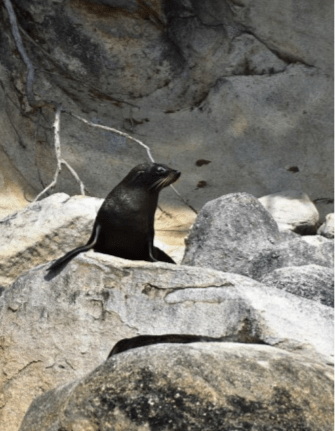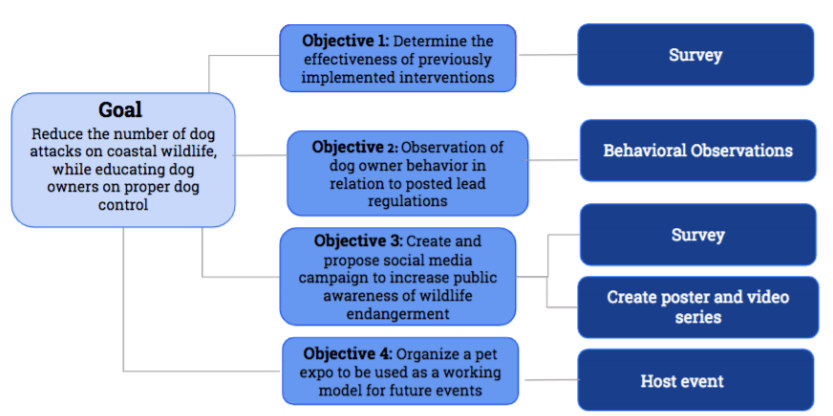Executive Summary
In numerous coastal communities in New Zealand, it is common for dog owners to encounter wildlife while walking their dogs along the coastline. These encounters have led to an increasing number of dog attacks on coastal wildlife, such as the little blue penguin and fur seal. Many of these species are endangered, which has led to the Department of Conservationintervening. In the past few years, there has been an increase in the number of regulations surrounding dogs and lead laws on beaches to mitigate this problem.
Figure A. Proctor, 2019
Our project, which is the conclusion of a multi-year project, focused on analyzing how effective these past measures have been in protecting endangered coastal wildlife and preventing dog attacks on beaches. We achieved this by surveying dog owners in the Greater WellingtonArea, as well as conducting behavioral observations. Also, we proposed a social media campaign consisting of posters and a video series, to increase dog owner awareness of coastal wildlife. Another focus of our project was to educate dog owners on the proper handling of dogs while around wildlife. We utilized the Lead the Way campaign and held a Pet Expo to demonstrate correct dog owner control. By implementing these new strategies, we hope to mitigate dog and coastal wildlife interactions.
Background
New Zealand is home to a variety of distinct species, including flightless birds. Since the first introduction of domesticated animals, New Zealand’s biologically diverse ecosystem has been threatened. The endangered coastal wildlife of New Zealand is especially a concern, as they often fall victim to dog attacks. These species include the little penguin, the yellow-eyed penguin, and the New Zealand fur seal. In recent years, there have been a number of attacks on little penguins along the coastline, which is often due to people walking their dogs offlead at the beach.
Figure B. Proctor, 2019
Penguins here live in small colonies making them vulnerable to dog attacks, especially during the molting season. As for seals, owners and their dogs can interrupt sleeping patterns and other critical behaviors. Dog attacks on seal pups have also been reported, raising even more concern. To combat these threats, lead laws are in place throughout New Zealand and vary among the beaches, depending on the coastal wildlife present in that area. The main method of informing the public of these issues and regulations is through posted signage. A method, not yet explored is social media. Social media is used in today’s society as a crucial tool for sharing information and often replaces other methods of communication. Our group plans to use social media as a method for informing the public of the threats dogs pose to coastal wildlife and to emphasize the importance of lead laws and regulations.
Methodology
The main goal of our project was to minimize the threat dogs pose to New Zealand’scoastal wildlife. We attempted to fulfill this goal by focusing in on four objectives to make dog owners more aware of the wildlife present on beaches and educate them on proper dog handling.
Figure C. Flow chart
Objective 1: Determine the effectiveness of previously implemented interventions, including signage and survey results
Last year, an Interactive Qualifying Project (IQP) team, a WPI student research project, was provided with a similar task by the New Zealand Department of Conservation (DOC). The focus of the project was to reduce the interactions between coastal wildlife and domesticated dogs. For our first objective, we analyzed the effectiveness of past DOC interventions put in place in 2018. To do this we surveyed dog owners at beaches in the Greater Wellington Area including Ngati Toa Domain, Whitireia Park, Oriental Bay, Lyall Bay, and Paekakariki beach.We administered the survey through the Qualtrics app and used it to analyze our results. The data was used to compare to the results from last year in order to identify trends and to determine how effective previous campaigns have been.
Objective 2: Observation of dog owner behavior in relation to posted lead regulations
While surveying dog owners at Greater Wellington Areas beaches, our group recorded behavioral observations. We took note of how many dogs were on-lead and off-lead at each beach while recording the posted lead regulations for that area. This helped us gain general knowledge about dog owner behavior based on how many dog owners followed the current lead laws.
objective 3: Create and propose a social media campaign to increase public awareness of wildlife endangerment
We conducted a social media survey that focused on understanding the social media references and habits of specific populations of dog owners. Using our results from our social media survey, we then proposed a social media campaign, to increase the Greater WellingtonArea public awareness for the endangered coastal wildlife species. By creating this social media campaign, we have helped DOC capitalize on the increasing popularity of digital technology in today’s world. From our initial social media survey results, we concluded that the most popular social media platform among dog owners in the Wellington area was Facebook. Knowing this, we designed two posters to be posted on relevant Facebook pages, in addition to a video series for the DOC website. A one minute video introduces the concern for dog interactions with wildlife, and later on, highlights threatened coastal species in the Greater Wellington Area, while also providing suggestions for dog owners. A mini video series was created focusing on the animals at risk.
Objective 4: Organize a pet expo to be used as a working model for future events
We hosted A Dog’s Day Out Pet Expo at Titahi Bay on the 16th of February, 2019. At the event, we promoted the Lead the Way campaign by organizing games for dog owners and their dogs to educate them on how to act in the presence of coastal species. We showed dog owners our proposed social media posters and videos, in order to gain feedback from the dog owners themselves.
Results & Discussion
Our initial survey gave us the information needed in order to determine if past DOCinterventions have been effective. One noteworthy finding is that 81% of dog owners reported being aware of endangered coastal wildlife, which shows that a vast majority are aware of the wildlife that DOC’s campaigns have targeted. Therefore, we can conclude that New Zealand dog owners are generally aware of coastal wildlife that are present on the beaches where they exercise their dog. Our data revealed that there are conflicting opinions among dog owners if dogs can pose a threat to wildlife. 45% of dog owners reported dogs can be a threat to wildlife, while 28% disagreed, and 27% remained neutral. The most common response we received from dog owners was “Some dogs can be a threat to wildlife, but my dog isn’t.”This finding shows that there is still work that needs to be done to educate dog owners that all dogs can be a threat to wildlife. Our behavioral observations supported this, as we found that dog owners are aware of lead regulations on the beaches but do not follow them. Additionally, we asked dog owners specifically about several DOC campaigns. Our data showed that 18% are aware of increased DOC lead law signage on beaches, 11% have heard of previous DOC Pet Expos, and 6% reported knowing about the Lead the Way campaign. These campaigns have been introduced recently and show great potential for growth in the future since the campaign is so new.
Our second survey provided insight into the social media behaviors of New Zealanders. The data collected showed that the average time spent on social media is between 2-4 hours per day. The overwhelming majority of dog owners responded that their preferred platform of social media is Facebook. Due to these responses, we tailored our social media campaign to be most effective on Facebook. We proposed four posters to be posted in relevant Facebook groups and developed an informative video series on this issue to be displayed on DOC’s website. Additionally, the majority of respondents reported they would respond favorably to our suggested campaign.
We held A Dog’s Day Out Pet Expo at Titahi Bay on the16th of February 2019. During this event, we promoted the Lead the Way campaign by inviting dog owners to play games with their dogs in order to educate them on proper dog control behaviors. The pet expo was successful in spreading awareness about the Lead the Way campaign and the issues surrounding dog and coastal wildlife interactions. A total of 50 people attended, along with 27 dogs, who responded positively to the messages we were spreading. A common response was “I learned a lot tonight. It was a very fun event, they should be held more often.” We also showed dog owners the posters and videos we created and we received positive feedback. One response that stood out was, “If you can get people to actually care about this issue, then they will be inspired to seek out more information on their own.” This shows that our proposed campaigns effectively get the message across and elicit a positive response in dog owners.
Figure D. Dog’s Day Out Flyer
Recommendations & Conclusion
The data and research collected for this project have allowed us to confidently suggest future recommendations for DOC surrounding the dog and coastal wildlife matter. Our main proposal is that social media should be utilized as a means of educating the public and promoting awareness of this issue. We have created a variety of sample posters, stickers, and videos that we suggest be launched as a social media campaign in the near future. A mini video series was created in order to highlight the main coastal wildlife species and be used for educational purposes.
Figure E. Lead the Way Flyer
During our time working on this project, we have learned that many dog owners are aware of the rules and regulations surrounding dog-wildlife interactions, yet do not follow them. Although our results show that many dog owners care about protecting the endangered coastal wildlife, they care about their dogs more. By introducing a social media campaign in the future, we hope that this will alter the attitudes of dog owners in the years to come.
Throughout the three years that dogs owners have been surveyed, we have seen positive changes through the implementations that have been introduced. Thus, interventions targeting dog owners over the last three years have made a positive impact on their knowledge of the dog and coastal wildlife issue, but there is still room for improvement.






